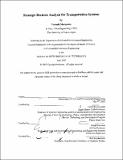Strategic decision analysis for transportation systems
Author(s)
Moriyama, Yasuaki, 1972-
DownloadFull printable version (11.42Mb)
Other Contributors
Massachusetts Institute of Technology. Dept. of Civil and Environmental Engineering.
Advisor
Fred Moavenzadeh and Joseph Sussman.
Terms of use
Metadata
Show full item recordAbstract
This thesis examines decision analysis methods of capital investment in transportation systems. The transportation system is a fundamental infrastructure, and requires strategic thinking in making decisions on its projects. The current valuation methods, however, do not reflect the strategic value of a project. We investigate how to make a strategic decision by comprehensively valuing a project in transportation systems. This study begins by analyzing the characteristics and risks of a railway project as an example of the transportation system, and comparing the current valuation methods based on this analysis. Current methods are useful in valuing a project when we can fairly predict its performance in the system. However, we have difficulty in valuing a project under uncertainty. Focusing on the present value of cash flows does not properly measure the significance of a strategic project, but real options value (ROV) is an effective tool to do it. We next examine the theoretical correctness of the real options as applied to a transportation project. The critical question is whether we can create a portfolio that replicates the payoffs of options even if we cannot trade the options in a market. We answer this question by proposing the complete market assumption in the real options. To this end, we analyze a case of a railway project with Binominal Model. ROV quantifies the strategic value of a project, and consequently improves the investment strategy. We show how it is critical to recognize options in a project and benefit from them to effectively develop transportation systems in a competitive market.
Description
Thesis (S.M.)--Massachusetts Institute of Technology, Dept. of Civil and Environmental Engineering, 2003. Includes bibliographical references (p. 117-119).
Date issued
2003Department
Massachusetts Institute of Technology. Department of Civil and Environmental EngineeringPublisher
Massachusetts Institute of Technology
Keywords
Civil and Environmental Engineering.